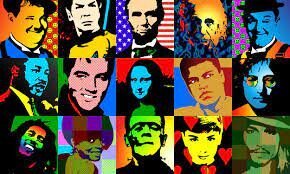Pop Art In America And Britain
The invention of Pop Art:-
The New York painters Andy Warhol, Roy Lichtenstein, James Rosenquist, and Claes Oldenburg began pop art and became part of a worldwide phenomenon. All of them drew on popular iconography. Pop Art was brash, young and fun, and hostile to the artistic establishment. It included different styles of painting and sculpture from various countries, but what they all had in common was an interest in mass media, mass production, and mass culture.
British Pop Art-
British pop art aimed to break a stagnant heritage of art where works were usually linked to mythical, biblical, or emotional subjects. This yearning for change has been the motive for pop art. Although most of its inspiration was predicated on the Dadaist language to create illogical mixtures of random pictures that respond from the day's beginning. British Pop artists found their original fodder in the brash, fun, and bold world of contemporary culture, entertaining, and daring environments. Fresh photographs began to overturn the historical bounds of the art by portraying current comedy, injecting their subjects with new vigor.
While British pop art takes great use of American publicity from the consumer boom after World War II, it stays separate from American pop art. It's because whereas American artists were motivated mostly by what they saw and experienced in their own society, early pop art in the UK was fuelled by a distanced American popular culture. Afterward, as the swinging musical and fashion scenes of London began to grow, British artists began to include the culture of their own nation as well.
In their works commemorating ads, albums, web pages from prominent magazines, posters, catalogs, and other advertising linked to the marketing, they were able to build works using new advertising and design processes, such as screen printing and graphic design. British pop art effectively broke the veil between high and low art by developing related pieces which modified the resonance inside the ordinary man.
American Pop Art:-
American pop art has tended to be iconic, nameless, and aggressive. American Pop art being more subjective and referential, expressed a somewhat romantic view of Pop culture fostered perhaps by England’s relative distance from it. English artists of pop culture tended mostly to deal with popular technology as subjects, even as metaphors; similar notions seemed to be lived by some American pop musicians. For instance, Warhol's slogan was, "I think everyone ought to be a machine" reflects that in his art, he strove to construct works that a machine could have done.
In America, pop art grew somewhat differently from the British. Evolution and response to Abstract Expressionist painting were the American Pop Art. Abstract Expressionism was the world's first American art movement, but many believed that it had grown too contemplative and aristocratic by the mid-1950s. American Pop Art originated as a tentative attempt to reverse this tendency by bringing the image into the actual world as a structural component in the painting. It was a model previously tested.
Picasso had done something similar forty years previously when he collaged 'real world' printed images onto his still lifes, as he feared that his painting was becoming too abstract. Around 1955, two remarkable artists emerged who would lay the foundations of a bridge between Abstract Expressionism and Pop Art. They were Jasper Johns and Robert Rauschenberg, the forerunners of American Pop Art.
By creating paintings or sculptures of mass culture, objects, and media stars, the Pop art movement aimed to blur the boundaries between "high" art and "low" culture. The concept that there is no hierarchy of culture and that art may borrow from any source has been one of the most influential characteristics of Pop art.









